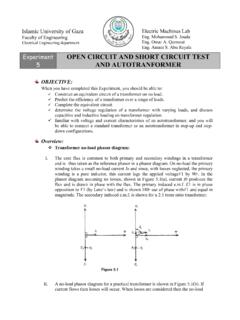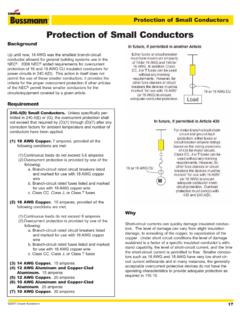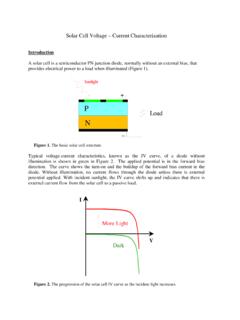Transcription of Numerical and Experimental Investigation of Internal Short ...
1 NREL is a national laboratory of the Department of Energy, Office of Energy Efficiency and Renewable Energy, operated byth e Alliance for Sustainable Energy, DOE Vehicle Technologies Program ReviewNumerical and Experimental Investigation of Internal Short Circuits in a Li-ion CellProject ID: ES109 This presentation does not contain any proprietary, confidential, or otherwise restricted informationPI: Matthew Keyser, Gi-Heon KimPresenter: Gi-Heon KimEnergy Storage Task Lead: Ahmad PesaranContributors:Matthew Keyser, Dirk Long, John Ireland, YoonSeok Jung, Kyu-Jin Lee, Kandler Smith, Shriram Santhanagopalan National Renewable Energy LaboratoryEric DarcyNational Renewable Energy Laboratory (Jan-Sep, 2010)NASA-JSCNATIONAL RENEWABLE ENERGY LABORATORYO verviewTimeline2 BudgetBarriersPartners Li-ion abuse tolerance and reliability Li-ion performance NASA-JSC DowKokam Battery Safety Consulting Inc. Battery Design LLC Sandia National Laboratories (SNL) NavyOverview Project Start: 2009 ProjectEnd : 2014 Ongoing FY10: $500K FY11.
2 Anticipated $500 KFunded by Dave Howell, Energy Storage R&DVehicle Technology Program, Department of EnergyNATIONAL RENEWABLE ENERGY LABORATORYB ackground3 Relevance Because ofits high specific energy and power density, the Li-ion battery (LIB) is a promising candidate to date for electric energy storage in electric drive vehicles(EDVs) Safety concerns regarding violent failure of the LIB system are a major obstacle to overcome for fast market acceptance of EDV technologies Thermal instability and flammability of the LIB components make them prone to catastrophic thermal runaway under some rare ISC conditions Many safety incidents that take place in the field are due to an ISC that is not detectable or predictable at the point of manufactureInternal Short circuit (ISC), a Major ConcernNATIONAL RENEWABLE ENERGY LABORATORYM otivation4 Relevance Evolving duringLife: Latent defect gradually evolves to create an ISC while the battery is in use; inadequate design and/or off-limit operation causes Li plating, stressing separator Difficulty of Early Detection: Electricaland thermal signals of early stage ISCs are not easily detected in large-capacity LIB systems Complex Physicswith Numerous Sensitive Factors: Behavior of a LIB with an ISC depends on various factors, including nature of the Short ; cell characteristics such as capacity, chemistry, electrical and configuration.
3 And attributes of the pack where the cell is integrated Poor Reproducibility: To date, no reliable and practical method exists to create an on-demand ISC in Li-ion cells that produces a response that is relevant to the ones produced by field failuresBarriers for Addressing Failures Due to ISCNATIONAL RENEWABLE ENERGY Investigation : Enhance knowledge of the complex physics of evolution and development of an ISC and subsequent cell responses using NREL s multiphysics ISC model Method Development: Establisha relevant ISC test method by developing an on-demand Short activation deviceto produce representative and reproducible ISCs in a active cell and relevant cell +Test: Perform a synergistic study with combination of modeling and Experimental approaches NATIONAL RENEWABLE ENERGY LABORATORYM ilestones6 Milestones Matthew Keyser,Dirk Long, Ahmad Pesaran, NREL Internal Short circuit Simulator Development Summary FY10 Milestone Report Li-Ion Abuse Response Modeling and Internal Short circuit Simulation FY11 Milestone Report Due in September 2011 NATIONAL RENEWABLE ENERGY LABORATORYA pproach7 ApproachModel Validation Confirm Model Assumptions Provide Model Input Identify Critical Parameters Provide Complete Data Set for Non-Measurable Quantities Multiphysics ISC modeling Understanding cell behaviors Develop relevant ISC in active cell Provide consistent and reproducible resultsLead Investigator: Gi-Heon KimLead Investigator: Matthew KeyserFocus of TestingStudy Focus of ModelingStudyExperiment DesignPhoto Credits: Dow Kokam Ben McCarthyPhoto Credits.
4 NREL Dirk LongNATIONAL RENEWABLE ENERGY LABORATORY8 Perform multiphysics ISC model study using NREL s electrochemical, electrothermal, and abuse reaction kinetics models Predict cell responses and onset of thermal runaway corresponding to the nature of the Short and cell characteristics Internal Short circuit ModelingElectrochemical (mm)soc [%]Y(mm) Internal Short Model StudysocCurrent DensityTemperatureElectrothermal ModelAbuse Kinetics ModelTCases for Short Path ISC between metal (Al & Cu) current collector foils ISC between electrode (cathode & anode) layers ISC between Al to anode Short bypassing cathode Impact of cell size Impact of ISC location CathodeAnode AlCuAlAnode Approach ModelingApproachNATIONAL RENEWABLE ENERGY LABORATORY9 Small, low-profile and implantable into Li-ion cells, preferably during assembly Consistent and repeatable activation of Internal Short Electrolyte-compatible phase change material (PCM)
5 For key component Triggered by heating the cell above PCM melting temperature Approach TestingApproachInternal Short circuit Instigator Device DevelopmentSpiral wound battery shown can also be applied to prismatic batteriesNATIONAL RENEWABLE ENERGY LABORATORYP revious Accomplishments10 Technical Accomplishments2040 sec828 Total Volumetric Heat Release from Component Reactions42416361232 Three-dimensional LIB abuse kinetics model was developed in support of DOE s ATD program, and the development was continued in the DOE s ABR program Previous study Focused on understanding the interaction between heat transfer and exothermic abuse reaction propagation for a particular cell/module design Provided insight on how thermal characteristics and conditions can impact safety events of LIBsInternal TExternal T( C)02040(sec)Note: Since NREL did not participate in 2010 AMR, this poster presentation include some of the project accomplishments done before May, RENEWABLE ENERGY LABORATORYA ccomplishments11 Technical AccomplishmentsISC Model InvestigationNATIONAL RENEWABLE ENERGY LABORATORYI mpact of Cell Capacity12 Technical AccomplishmentsInitial cell heating pattern under ISC varies with cell capacity Shorted area.
6 1 mm x 1 mm Rshort~ 10 m Ishort~ 300 A (15 C-rate)Temperature at 10 sec after short800 C25 Csurface temperatureinternal temperature Short between Al and Cu foils20 Ah Ah cell Rshort~ 7 m Ishort~ 34 A (85 C-rate) [ C] volume fractionvolume fraction100C140 CTemperatureat 7 sec after shortTemperatureat 8 sec after short0102030405060024681012 Exothermic Reaction Heat [kW]Time [sec]20 sec10 sec30 sec50 sec40 sec60 secTemperature evolving with time200 mm140 mmShorted SpotPositive TabNegative Tab40 mm35 mm3 mmShorted Spot A small-capacity cell is heated globally ISC heating in a large cell is likely local Thermally triggered shut-down separator may function effectively in a small cellNATIONAL RENEWABLE ENERGY LABORATORYI mpact of Separator Integrity13 Technical AccomplishmentsMaintaining integrity of separator seems critical to delay evolution of the Short Shorted area: 1 mm x 1 mm Rshort~ 20 Ishort~ A (< C-rate)current density field near shortsurface Thermal signature of the Short is hard to detect from the surface The Short for simple separator puncture is not likely to lead to an immediate thermal runawayseparator hole propagationShorted area.
7 3 cm x3 cm Rshort~ 30 m Ishort~ 100 A (5 C)3cm x 3cm Separator HoleExothermic Heat [W]Time [sec]Temperature at 1min after short1cm x 1cm Separator HoleJoule heat @ cathode layerJoule heat @ foils Short between anode to cathode 20 Ah capacity cellNATIONAL RENEWABLE ENERGY LABORATORYI mpact of Short Paths14 Technical AccomplishmentsElectrical resistance of ISC varies with Short path across electrodes 20 Ah capacity cellShort betweenAl & Cu foilsShort betweenanode and cathodeShort betweenanode and Al foil Rshort~ 10 m Ishort~ 300 A (15 C-rate)Temperatures at 10 sec after short800 C25 Csurface temperatureinternal temperature Rshort~ 20 Ishort~ A (< C-rate)Temperatures at 20 min after Cinternal temperatureTemperatures at 1 hr after shortsurface temperaturesinternal temperatures250 C37 C Rshort~ 2 Ishort~ A (< C- rate) ISC bypassing cathode is likely to evolve into a hard Short in relatively brief timeNATIONAL RENEWABLE ENERGY LABORATORYI mpact of Short Location15 Technical AccomplishmentsCell response varies with Short location and cell electrical configurationSurface Temperatures 20-Ah capacity stacked cellISC Far from Tab0102030405060024681012 Exothermic Reaction Heat [kW]Time [sec]900 C50 CISC Near Tab ISC far from tab Rshort~ 10 m Ishort~ 300 A (15 C-rate) Electric Potential at Shorting Layers Rshort~ m Ishort~ 520 A (26 C- rate)
8 300oC30oCInternal Temperatures For low-resistance ISC, near-tab ISC results in a smaller resistance because of shorter Short -current path through shorting layers Pattern of local heating for convergence of Short -current varies with location of Short and Internal electrical configuration of a cellSurface TemperaturesISC Near Tab NATIONAL RENEWABLE ENERGY LABORATORYA ccomplishments16 Technical AccomplishmentsISC Test Method DevelopmentNATIONAL RENEWABLE ENERGY LABORATORYNREL ISC Device17 Technical AccomplishmentsNREL developed an on-demand activation device creating representative ISCS eparatorPositive current collector (Al)Cathode electrodeISC deviceNegative current collector (Cu)Anode electrodeActivated Short with PCM wickedby battery separatorPhoto Credit: Dirk Long, NREL Triggered by heating the cell above PCM melting temperature (presently 40 C 60 C) Initial device design focus is on anode-to-cathode active material Short Improved device design focus is on anode-to-Al Short NREL s ISC instigator designWax Anode to Cathode ISC Anode to Al ISCThis device is applied for patentNATIONAL RENEWABLE ENERGY LABORATORYC haracterizing the ISC Device 18 Technical AccomplishmentsModel helps to understand characteristics of ISC device and Short triggeredAxis symmetry geometry Current Boundary ConditionGround Boundary ConditionPropertyAl padCu padCu piecePositive current collectorNegativecurrent collectorCathode electrodeAnode electrodeSeparatorElectric conductivity [S/m]
9 No interface contact resistance between componentsElectric potential contourCurrent density norm contourGraphic not drawn to scale Cathode layer is the most resistive part in the Short current path Short current is mostly carried by metal foilsseparatorNATIONAL RENEWABLE ENERGY LABORATORYISC Device Function Test19 Technical AccomplishmentsNREL ISC device consistently activated a Short in laboratory (Amps), Temperature (oC)Voltage Drop Across Platens (Volts) Time (Seconds)VoltageCurrentTemperatureConsis tent Short Impedance ~ m Impedance test Coin cell Platen Temperature (oC)Coin Cell Voltage (Volts)Time (Minutes)VoltageTemperatureReliable ISC Trigger in Coin Cells 100% Success Rate In laboratory testing, the activated device can handle currents in excess of 200 A to simulate hard shorts (<5m ). Phase change from non-conducting to conducting has been 100% successful during trigger tests. Separator is an excellent wick for melted PCM.
10 Nine of nine coin cells shorted with new ISC device design, shown here using a 42 C 44 C melting Credit: Dirk Long, NRELNATIONAL RENEWABLE ENERGY LABORATORYISC Device Implantation in a Large Cell e ( Volts)Time (Minutes)Cell 11 Cell 12 Cell 134- amp discharge voltage curves from initial cycle dataDow Kokam 8-Ah pouch cells with anode-Al ISC deviceDevice has negligible impact on cell 11 capacity = AhCell 12 capacity = AhCell 13 capacity = AhTechnical AccomplishmentsImplantation of NREL ISC device does not impact electrochemical performance of 8-Ah Dow Kokam cellsNATIONAL RENEWABLE ENERGY LABORATORYI mplanting Anode-to-Cathode ISC in 8-Ah cells21 Technical AccomplishmentsISC was consistently activated in 8-Ah stacked cells using NREL s ISC device Implantation of ISC Device for Anode to Cathode shortAnode electrodeCathode electrodeISC device Cu sideVoltage Response to ISC Shown here implanted inside a Dow Kokam 8-Ah pouch cell ISC device Al side Thermal runway was not observed due to high impedance of the ISC between anode-to-cathode electrode surfaces Photo Credits.



















